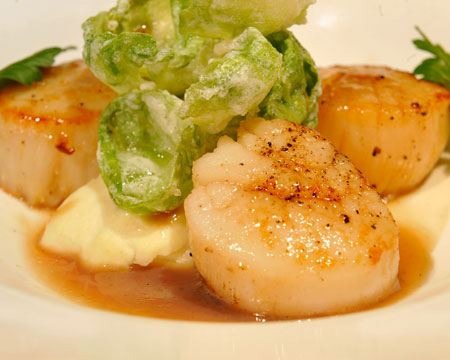How To Cook Scallops To Perfection
Scallops are a tricky thing to master. They're incredibly delicate, so the amount of heat used is important and the timing is absolutely key, and they're shellfish, so they have elements from the sea that play into the chemistry of their cooking. The perfectly cooked scallop is one that has a golden brown crust on the outside, and a tender, succulent texture on the inside, but because of the factors outlined above, it's not always easy to attain this result.
Recently, I cooked with chef Didier Montarou of InterContinental Hotel Boston for the resort's Kitchen Passport Program, during which we developed recipes for their iPad cookbook. The first recipe we came up with was honey-glazed scallops. As I had struggled with cooking scallops in the past, I was excited to learn from the talented chef. For our recipe, we used ingredients that were native to our setting — scallops because we were in Boston and honey because the hotel had its own bee farm on the roof. First, we seasoned and seared the scallops over high heat, and then we removed them from the pan and created a rich, easy honey glaze to finish them in.
Click here to see the Honey-Glazed Scallops with Tempura Brussels Sprouts and Parsnip Purée Recipe
Our recipe was delicious, but it wouldn't have been anything to marvel at unless those scallops were cooked to perfection like they were. Along with an innovative and unique recipe (which included a parsnip purée and tempura-fried Brussels sprouts), I took away some key things to remember when cooking scallops, which will help you attain the perfectly cooked scallop.
- Dry them. Scallops' moist characteristics make it a challenge to get that perfect golden crust unless they're patted dry before cooking. Chef Montarou recommends seasoning them and then patting them down with a dry paper towel before adding them to the pan so that the salt helps extract some moisture.
- Use a piping hot pan. I couldn't believe it when I saw it, but we didn't add our scallops to the pan until we saw smoke rising from it — literally. As soon as you add them, you'll know what you're doing is right because you'll hear a perfect symphony of sizzles and cracks that are creating the perfect sear. The hot pan also helps to sear the scallops fast enough so that they don't overcook.
- Speaking of which, don't overcook them. Because scallops are seafood, it's less important that they're cooked all the way through than it is that they retain that tender texture only a creature of the sea can have. Montarou says that larger scallops should never take more than one minute per side, and even less for smaller ones.
- Don't overcrowd the pan. Moisture can become a problem once they're in the pan as well, especially if you try to cook too many scallops at once. Overcrowding the pan will lower the heat level and their juices will prevent the perfect sear.
Anne Dolce is the Cook Editor at The Daily Meal. Follow her on Twitter @anniecdolce
